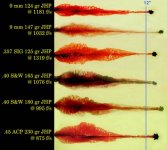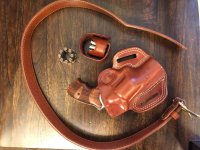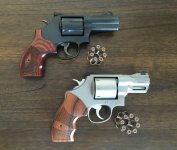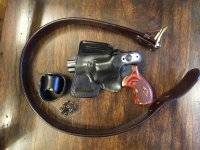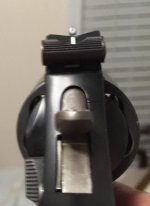dwever
Member
S&W Revolver Carry Purchase Checklist
As Clint Smith says on his Thunder Ranch web site, "In the hands of knowledgeable persons the revolver is more than an equal of any other defensive handgun." I agree with that. And, making that a reality is the same with any fire arm platform: quality training, more quality training, practice, equipment, and more training.
In this brief excurses I will deal with equipment. I am NOT trying to tell you what weapon system is best for you for defensive carry. That would be arrogant and how could I possibly know that? So my statements are ultimately no more than why I carry and purchase what I do, not what you should do.
I'll also touch on why I choose to move from a couple of 1911 Wilson Combat platforms to an S&W revolver; and, what defensive purchase criteria emerged for me from that transition to the point that I'm now qualified with a 586 L-Comp with my agency (mandatory Glocks though in uniform). And, what follows below will be towards the goal of representing the "more than an equal" statement made by Clint Smith.
Before beginning, let me mention a few presuppositions or prejudices if you prefer that I bring to the discussion
First, from a carrying stand-point, we would all love it if our gun was tiny and only weighed 13 ounces. However, given that the weapon has good concealment, we should within reason accept the weapon weight necessary to have the requisite recoil management for a load that will meet or be in the neighborhood of FBI penetration and expansion minimum standards, and a weapon that also allows for quick and accurate follow-up. Too many carry decisions are made based on I-can-barely-feel-it-in-my-pocket carry comfort. But then these diminutive alloy weapons loaded with adequate +P .38 ammunition, when compared to their 30 plus ounce big brothers, they are generally wrist breakers, lack accuracy, and lack follow-up.
Second, people respond to the first point by saying that none of the increased capability does them any good if the weapon is too heavy to carry. True. But just be clear that is not a limitation statement, that is a willingness statement. We can virtually all carry a thirty-ounce platform, but we may not be willing to do so. So presupposition number two is, we can carry a concealable system with serious fire power, but to do so, even for good marksman, we must generally speaking be willing to carry a weapon that will weigh well in excess of 13.5 ounces. If you are capable of rapid fire shooting six to eight inch groups at seven yards with an air-weight, your skills exceed what I am writing for here, and I wish I could shoot like you do.
Third, so the big presupposition I am driving at is that for a revolver to incarnate being "the equal of any defensive handgun", that eliminates from consideration certain diminutive equipment unless you are a very elite shooter.
So those are a few prejudices I bring to the table. I am about to buy a PC 686 Plus for carry, and my current carry is either a PC 586 L-Comp with night sights (primary), and a PC 627 UDR (secondary, particularly in cool weather daylight). I compete favorably against semi-autos with the 627 platform, and the 586 L-Comp has done fine, even with seven reloads, in our agency's course of fire. So, moving forward, the PC 686 Plus met the following criterion for me:
1. It is at least a steel L frame. To be on equal footing with semi-autos I must be able to send adequate +P .38's down range quickly and accurately. The weight of a steel L-Frame can easily manage the recoil of +P 38's and lighter .357 Magnum loads (e.g. in .357 Mag Speer Gold Dot SB JHP). Both my 586 L-Comp and 627 UDR weigh in at 37 oz. empty. I think the 686 Plus is 34 oz. and change. Unlike an N Frame, the width of an L-Frame is narrow enough for IWB carry too.
2. It has a minimum of seven chambers because they're available. An L frame allows for 7-Round capacity meaning a single reload is almost equivalent to two successive reloads with a J frame (14 – 15); or course an 8-Round N Frame is 16 rounds after one reload.
3. The cylinder will be cut for moon-clips. Extremely fast full-reloads must be possible. A Glock 34 by comparison has 18 rounds (17 + 1). I use carbon steel moon clips for carry due to their resistance to bending. I use alloy in competition. Also, a moon clip carrier is nice as bending is unlikely in your pocket, but in a carrier that potential is virtually eliminated (mine are converted speed loader pouches by Galco).
4. The barrel will have a length <= 3" for concealment. Mine are 3", 2.625", and a 2.5" is on deck.
5. One weapon will have night sights since the unthinkable tends to happen at night. That is my 586 L-Comp (XS Systems Standard Dot and installed by TK Custom).
6. Will almost certainly go in for action work. While revolvers in general and PC revolvers in particular can be delivered with some very good action, this is a you-bet-your-life platform, and it is worth it to go from very good to best in the hands of a master revolver smith. I have used TK Custom in the past.
7. I'll have a non-retention holster (such as a Galco Combat Master) and a retention holster (e.g. Galco silhouette high ride) for each as well as a moon clip carrier. For the L-Frame also an IWB holster.
8. For the above criterion in an S&W, it will most likely be a performance center gun.
9. I'll be changing the 686 3 finger grips to match the grips on my existing weapons. I want weapon purchase to be virtually identical at the draw for obvious reasons.
10. I try to attend one school or significant training event a year with the revolver; and compete with the revolver intermittently. I bought two cases (2,000 rounds total for $840) of American Eagle .38 this year for practice, 500 rounds of Federal White Box for competition ($170), and a little +P. I just went to the garage and there were seven 50 round boxes of .38 AE left, most of the +P I bought, and the white box is gone; so that tells me most of my .38 shooting history as far as rounds through for the year.
Finally, I mentioned earlier I ditched a couple of Wilson Combat 1911's to move back to a revolver. I had two carbon steel full size 1911's in a CQB Elite in .45 and an X-Tac in 9mm. Phenomenal platforms, the 9mm being the fastest most accurate weapon I've ever owned. However, ever-so-rarely, they malfunctioned, and were waaaay higher maintenance in order to keep the malf's rare. Moreover, Glocks at a fraction of the cost are more reliable in my experience.
Revolvers are fallible, but arguably as close to utter reliability as possible among fire arms; and, as Mr. Smith said, "more than an equal of any other defensive handgun."
The above information is offered respectfully and with regard for differing opinions and experience. Thank you for the dialogue.
Peace
As Clint Smith says on his Thunder Ranch web site, "In the hands of knowledgeable persons the revolver is more than an equal of any other defensive handgun." I agree with that. And, making that a reality is the same with any fire arm platform: quality training, more quality training, practice, equipment, and more training.
In this brief excurses I will deal with equipment. I am NOT trying to tell you what weapon system is best for you for defensive carry. That would be arrogant and how could I possibly know that? So my statements are ultimately no more than why I carry and purchase what I do, not what you should do.
I'll also touch on why I choose to move from a couple of 1911 Wilson Combat platforms to an S&W revolver; and, what defensive purchase criteria emerged for me from that transition to the point that I'm now qualified with a 586 L-Comp with my agency (mandatory Glocks though in uniform). And, what follows below will be towards the goal of representing the "more than an equal" statement made by Clint Smith.
Before beginning, let me mention a few presuppositions or prejudices if you prefer that I bring to the discussion
First, from a carrying stand-point, we would all love it if our gun was tiny and only weighed 13 ounces. However, given that the weapon has good concealment, we should within reason accept the weapon weight necessary to have the requisite recoil management for a load that will meet or be in the neighborhood of FBI penetration and expansion minimum standards, and a weapon that also allows for quick and accurate follow-up. Too many carry decisions are made based on I-can-barely-feel-it-in-my-pocket carry comfort. But then these diminutive alloy weapons loaded with adequate +P .38 ammunition, when compared to their 30 plus ounce big brothers, they are generally wrist breakers, lack accuracy, and lack follow-up.
Second, people respond to the first point by saying that none of the increased capability does them any good if the weapon is too heavy to carry. True. But just be clear that is not a limitation statement, that is a willingness statement. We can virtually all carry a thirty-ounce platform, but we may not be willing to do so. So presupposition number two is, we can carry a concealable system with serious fire power, but to do so, even for good marksman, we must generally speaking be willing to carry a weapon that will weigh well in excess of 13.5 ounces. If you are capable of rapid fire shooting six to eight inch groups at seven yards with an air-weight, your skills exceed what I am writing for here, and I wish I could shoot like you do.
Third, so the big presupposition I am driving at is that for a revolver to incarnate being "the equal of any defensive handgun", that eliminates from consideration certain diminutive equipment unless you are a very elite shooter.
So those are a few prejudices I bring to the table. I am about to buy a PC 686 Plus for carry, and my current carry is either a PC 586 L-Comp with night sights (primary), and a PC 627 UDR (secondary, particularly in cool weather daylight). I compete favorably against semi-autos with the 627 platform, and the 586 L-Comp has done fine, even with seven reloads, in our agency's course of fire. So, moving forward, the PC 686 Plus met the following criterion for me:
1. It is at least a steel L frame. To be on equal footing with semi-autos I must be able to send adequate +P .38's down range quickly and accurately. The weight of a steel L-Frame can easily manage the recoil of +P 38's and lighter .357 Magnum loads (e.g. in .357 Mag Speer Gold Dot SB JHP). Both my 586 L-Comp and 627 UDR weigh in at 37 oz. empty. I think the 686 Plus is 34 oz. and change. Unlike an N Frame, the width of an L-Frame is narrow enough for IWB carry too.
2. It has a minimum of seven chambers because they're available. An L frame allows for 7-Round capacity meaning a single reload is almost equivalent to two successive reloads with a J frame (14 – 15); or course an 8-Round N Frame is 16 rounds after one reload.
3. The cylinder will be cut for moon-clips. Extremely fast full-reloads must be possible. A Glock 34 by comparison has 18 rounds (17 + 1). I use carbon steel moon clips for carry due to their resistance to bending. I use alloy in competition. Also, a moon clip carrier is nice as bending is unlikely in your pocket, but in a carrier that potential is virtually eliminated (mine are converted speed loader pouches by Galco).
4. The barrel will have a length <= 3" for concealment. Mine are 3", 2.625", and a 2.5" is on deck.
5. One weapon will have night sights since the unthinkable tends to happen at night. That is my 586 L-Comp (XS Systems Standard Dot and installed by TK Custom).
6. Will almost certainly go in for action work. While revolvers in general and PC revolvers in particular can be delivered with some very good action, this is a you-bet-your-life platform, and it is worth it to go from very good to best in the hands of a master revolver smith. I have used TK Custom in the past.
7. I'll have a non-retention holster (such as a Galco Combat Master) and a retention holster (e.g. Galco silhouette high ride) for each as well as a moon clip carrier. For the L-Frame also an IWB holster.
8. For the above criterion in an S&W, it will most likely be a performance center gun.
9. I'll be changing the 686 3 finger grips to match the grips on my existing weapons. I want weapon purchase to be virtually identical at the draw for obvious reasons.
10. I try to attend one school or significant training event a year with the revolver; and compete with the revolver intermittently. I bought two cases (2,000 rounds total for $840) of American Eagle .38 this year for practice, 500 rounds of Federal White Box for competition ($170), and a little +P. I just went to the garage and there were seven 50 round boxes of .38 AE left, most of the +P I bought, and the white box is gone; so that tells me most of my .38 shooting history as far as rounds through for the year.
Finally, I mentioned earlier I ditched a couple of Wilson Combat 1911's to move back to a revolver. I had two carbon steel full size 1911's in a CQB Elite in .45 and an X-Tac in 9mm. Phenomenal platforms, the 9mm being the fastest most accurate weapon I've ever owned. However, ever-so-rarely, they malfunctioned, and were waaaay higher maintenance in order to keep the malf's rare. Moreover, Glocks at a fraction of the cost are more reliable in my experience.
Revolvers are fallible, but arguably as close to utter reliability as possible among fire arms; and, as Mr. Smith said, "more than an equal of any other defensive handgun."
The above information is offered respectfully and with regard for differing opinions and experience. Thank you for the dialogue.
Peace
Attachments
Last edited:

